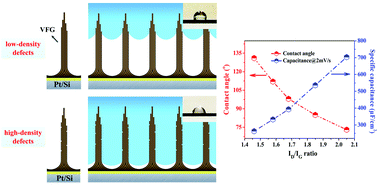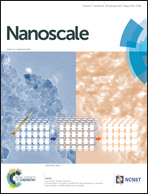A high-performance supercapacitor of vertically-oriented few-layered graphene with high-density defects†
Abstract
Pristine graphene with a 3D structure is desired for use in graphene-based supercapacitors, yet the very poor wettability of such graphene in water has limited its practical application. Here we report a way to simultaneously realize the 3D structure and good wettability in vertically-oriented few-layered graphene (VFG) grown by plasma-enhanced chemical vapor deposition. Based on scanning and transmission electron microscopic, Raman spectroscopic, contact angle (CA) and electrochemical analyses, a mechanism to explain the improved performance of VFG-based supercapacitors by defect-stimulated increases in wettability is proposed. The CA of our VFG samples notably reduces from 131° to 73° as the content of surface defects increases, which confirms that the wettability of VFG is markedly improved with an increased density of surface defects. Electrochemical results indicate that the VFG samples with a high density of defects exhibit high specific capacities of up to 704 μF cm−2 and a good cycling stability with about 91.2% capacitance retention after 3000 cycles. The excellent supercapacitor performance of the VFG samples with a high density of defects makes them attractive candidates for ultrathin high-performance supercapacitor electrodes.


 Please wait while we load your content...
Please wait while we load your content...